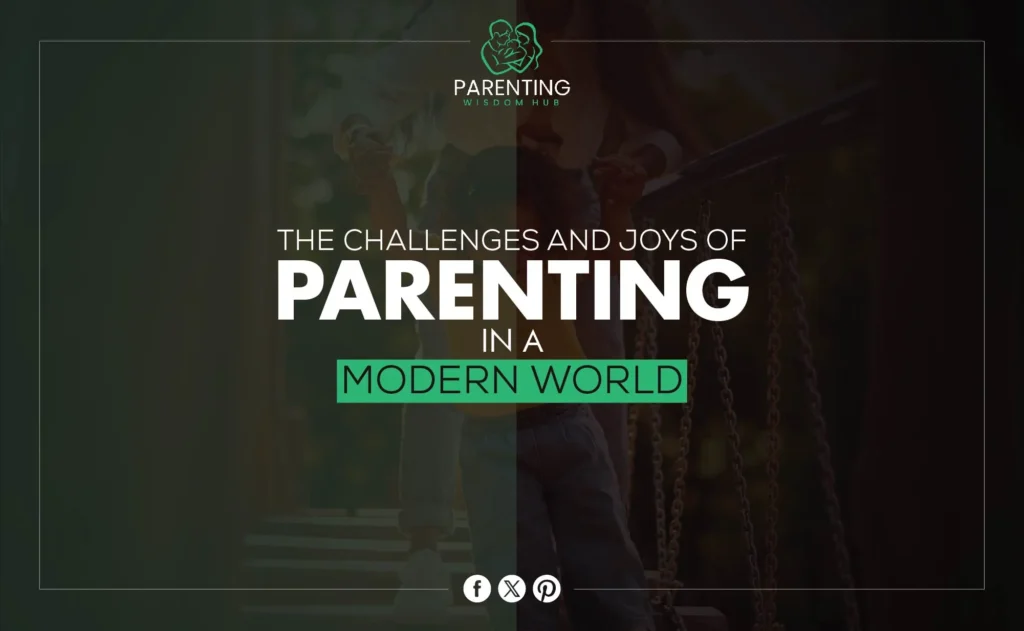Introduction
Imagine a world where your child says “Alexa” instead of “mama” or “dada.” It may seem unlikely, yet this is modern parenting. A recent study found that 8–18-year-olds spend 7.5 hours a day on screens, redefining parenting in a modern world.
Society, technology, and family interactions have changed rapidly in recent decades. From smartphones and tablets to social media and the internet, technology has permeated our daily lives. These advancements have changed how we raise our children, creating new problems and opportunities for parents.
This blog will examine parenting in a modern world through the lens of technology, changing parenting styles, work-life balance, and mental and emotional health. By recognizing these factors, parents can design effective techniques to raise children nowadays.
Technology and Parenting
Navigating Digital Parenting
How Technology Has Integrated into Family Life:
Technology has become essential to modern families. Technology is everywhere in our homes, from smart home devices and educational apps to entertainment and communication platforms. Children today are digital natives, raised with technology in their daily lives.
Guidelines for Setting Digital Boundaries and Managing Screen Time:
Parents must set digital boundaries to ensure technology benefits growth. The American Academy of Pediatrics advises one hour of screen usage per day for 2–5-year-olds and consistent restrictions for older kids. Set screen-free zones during meals and bedtime and exemplify balanced digital use as parents.
Apps and Tools that Support Healthy Tech Habits:
Several apps and tools can track and regulate screen time. Google’s Family Link lets parents limit screen time and monitor app usage. Circle is another program that limits screen time and content on household Wi-Fi devices. These can help kids have a healthy digital life.
Cybersecurity and Children
The Importance of Online Safety for Kids:
Internet use raises the risk of improper information, cyberbullying, and online predators for children. Modern parents must protect their kids online. Protection requires educating youngsters about internet hazards and setting regulations for safe use.
Practical Steps for Parents to Protect their Children Online:
Parents can take various practical online safety measures. Parental control software can monitor and block hazardous content. Social networking and other platform privacy settings are essential. Third, routinely addressing internet experiences with kids might help them feel comfortable sharing concerns.
Educational Resources for Teaching Kids about Cyber Safety:
Many resources teach kids online safety. Safe internet behaviors are covered on Common Sense Media and other websites.
Evolving Parenting Styles
Gentle Parenting
Definition and Principles:
Gentle parenting raises children with empathy, respect, understanding, and boundaries. It requires parents to consider their child’s feelings and needs and use positive reinforcement rather than punishment. Empathy, respect, understanding, and trust are essential values for strengthening parent-child bonds.
Benefits and Real-Life Applications in Modern Families:
Gentle parenting has many benefits. Children reared this way have higher self-esteem, better emotional regulation, and healthier parent-child interactions. This may involve parents supporting their child’s feelings, maintaining routines, and fostering open communication. Instead of condemning a child for a tantrum, a loving parent may help them identify and express their emotions.
Challenges and How to Overcome Them:
Gentle parenting can be difficult despite its rewards. It takes patience, consistency, and a lot of time and emotion. Parents may face social pressure to use authoritarian approaches. Parents can find support from like-minded communities, use gentle parenting practices, and remember the long-term benefits for their child’s emotional and social development to overcome these problems.
Helicopter vs. Free-Range Parenting
Compare and Contrast these Two Parenting Styles:
Free-range and helicopter parenting are opposite extremities of the parenting continuum. Helicopter parents actively monitor their children’s activities and decisions, while free-range parents let their kids explore and develop on their own with little supervision.
Effects on Children’s Development and Independence:
The consequences of various parenting styles on kids vary. Helicopter parenting can make kids feel weak and dependent, affecting their problem-solving and resilience. Free-range parenting can promote independence, confidence, and self-sufficiency, but it can also put children at risk if not controlled properly.
Balancing Oversight with Freedom:
The balance between these two techniques is essential. Parents can guide their children to guarantee their safety and well-being while encouraging independence and critical thinking. Setting clear boundaries, encouraging age-appropriate responsibilities, and progressively expanding autonomy as children show readiness can accomplish this balance.
Work-Life Integration
The New Normal of Remote Work
Impact of Remote Work on Family Routines:
Remote work has transformed family life. It gives parents more time at home but blurs work-family boundaries. This integration can improve family bonding but also stress from juggling work and parental commitments.
Tips for Balancing Professional Responsibilities with Parenting:
To balance work and parenting, you need to plan. To help you handle both, here are some tips:
- Set a Schedule: Set aside time each day for work, breaks, and spending time with your family.
- Prioritize Tasks: Focus on the most important jobs and delegate when you can to get your work done.
- Communicate: Talk to your boss and family about your wants and availability as often as possible.
- Use Technology: To stay prepared and make good use of your time, use productivity tools and apps.
Creating a Productive Home Environment for Both Work and Family:
A clean and organized home can help with both work and family obligations. Take a look at these strategies:
- Designate Workspaces: To cut down on distractions, set aside areas for work and family tasks.
- Establish Boundaries: Setting clear boundaries between work and home time can help you stay focused and less stressed.
- Involve the Family: Set rules and routines that everyone follows to help your family make the house a peaceful place to live.
- Self-Care: Make sure you take time for self-care to keep your health and energy up. This is important for juggling both jobs well.
Prioritizing Family Time
The Significance of Intentional Family Time:
Intentional family time helps youngsters develop strong bonds and a sense of security and belonging. It boosts family unity, communication, and emotional connection. Prioritizing family time can improve children’s and parents’ well-being.
Creative Ways to Spend Quality Time Together:
Here are some creative ways to spend time with your family:
- Family Game Nights: Game nights that happen on a regular basis can be a fun and social way to get to know each other.
- Outdoor Adventures: Plan walks, bike rides, or picnics so that you and your friends can enjoy nature and get some exercise.
- Cooking Together: Getting kids involved in making meals is a great way to teach them useful skills and make memories with them.
- Themed Nights: Think about having movie nights with a theme or culture nights where you learn about foods and traditions from around the world.
Balancing Extracurricular Activities and Family Commitments:
Planning is needed to find a good balance between kids’ extracurricular interests and family time:
- Limit Activities: Please limit the number of extracurricular things your kids do to make sure they don’t have too many to do.
- Schedule Family Time: Set aside specific times on the calendar for family events to ensure they are completed first.
- Be Flexible: Change family plans as needed to account for shifting schedules and unplanned events.
- Quality Over Quantity: Pay attention to the quality of the time you spend together instead of the amount. Make each moment count and stick in your mind.
Mental and Emotional Well-being
Parental Self-Care
The Importance of Self-Care for Parents:
Self-care is essential for parents since it affects child care. Parents can handle parenting stress better when they prioritize their health. Self-care reduces burnout, promotes mental health, and teaches children about self-care.
Strategies for Managing Stress and Maintaining Mental Health:
Parents can reduce stress and maintain mental health in numerous ways:
- Regular Exercise: Being active makes you feel better and lowers your worry. Whether it’s a daily walk, yoga, or a workout, make exercise a part of your life.
- Mindfulness and Meditation: Meditation or mindfulness can help parents anchor and manage stress. A few minutes of guided meditation or deep breathing can help.
- Hobbies and Interests: Go for fun and relaxation. Hobbies like reading, gardening, and crafting can help parents relax.
- Adequate Rest: Put rest and sleep first. Getting enough sleep is good for your body and mind and makes it easier to deal with the problems that come up every day.
Finding Support Networks and Resources:
Parents can benefit a lot from support networks and other tools. You can do any of these:
- Family and Friends: Use the people in your network to help you. Don’t be afraid to ask for help or talk about your problems with people you trust.
- Parenting Groups: You can meet other parents who understand what you’re going through and can offer support and help by joining parenting groups in your area or online.
- Professional Help: Contact mental health experts if needed. Therapists and counselors help manage stress and improve mental health.
- Community Resources: Use community parenting workshops, support hotlines, and wellness initiatives.
Children’s Emotional Health
Recognizing and Addressing Children’s Emotional Needs:
Understanding and meeting children’s emotional needs is vital to their health. Children who need emotional assistance may show behavior changes, disengagement, mood swings, and concentration issues. By responding to these signs, parents may help youngsters express their feelings in a safe environment.
Techniques for Fostering Resilience and Emotional Intelligence:
Several methods can be used to help kids develop grit and emotional intelligence:
- Open Communication: Encourage kids to talk about how they feel and pay attention when they do. Support their feelings and help them put their thoughts into words.
- Problem-Solving Skills: Kids need to learn how to make choices and solve problems. They should be able to fail and learn from it in a safe setting.
- Empathy and Understanding: Be kind and understanding to show that you care and understand. Encourage kids to think about how other people feel and what they think.
- Positive Reinforcement: Boost self-esteem and confidence by giving people good things. Do not just praise results; also praise effort and growth.
Professional Resources and When to Seek Help:
There are times when a child needs professional help to improve their mental health:
- Counselors and Therapists: Child psychologists and therapists can help with specific mental and behavioral problems.
- School Resources: Use school counselors and other support programs that schools offer.
- Support Groups: Sign kids up for support groups so they can meet other kids who are going through the same things.
- Warning Signs: Get professional help if a child is having serious or ongoing emotional problems, such as being sad for a long time, feeling anxious, or changing how they eat or sleep.
Diversity and Inclusion in Parenting
Raising Inclusive Children
Teaching Children about Diversity and Acceptance:
Today’s globalized society requires teaching kids about diversity and inclusion. Beginning with diversity, parents might explain that people have diverse backgrounds, cultures, abilities, and opinions. Books, movies, and educational programs with varied characters and stories can help start these talks.
Encouraging Empathy and Understanding of Different Cultures:
To raise open kids, you need to start by teaching them empathy and understanding. To get your kids to learn about and value other cultures, do the following:
- Cultural Exchange: Go to cultural events or take part in cultural exchange programs.
- Diverse Friendships: Help kids make friends with kids from different backgrounds.
- Travel and Exploration: If you can, take your kids on trips to different places to learn about other countries and ways of life.
Celebrating Diversity through Family Activities and Discussions:
Celebrating differences can be fun and teach you a lot. Include things to do that show off different countries and traditions, like
- Cooking International Meals: Make meals from different countries and talk about where they come from and what they mean.
- Storytelling: Listen to and tell tales from all over the world.
- Cultural Holidays: Celebrate different national holidays and talk about why they’re important.
Parenting in Diverse Families
Challenges and Strengths of Multicultural and Blended Families:
Cultural expectations, language obstacles, and merging family traditions are common challenges for multicultural and blended families. A rich cultural background and a broader perspective on life are also strengths of these families. Accepting these variances can strengthen family life.
Tips for Creating Harmony and Understanding within Diverse Family Units:
Harmony in families with different members takes work and planning. Here are some ideas:
- Open Communication: Encourage people to talk about societal differences and expectations openly and honestly.
- Respect Traditions: Please respect each other’s customs and find ways to incorporate them into your family life.
- Shared Experiences: Plan family activities that honor both cultures, like holiday parties or trips to cultural sites.
- Education: Teach yourself and your kids about the different cultures that live in your family.
Conclusion
Modern parenting presents distinct challenges and delights, especially when it comes to diversity and inclusiveness. Parents may create well-rounded, inclusive children by educating diversity, promoting empathy, and honoring different cultures. Accepting diversity and sharing experiences strengthens family bonds in multicultural and blended households.
Diversity and inclusion in parenting are about developing a family that recognizes and respects each member’s individual history and educating children for a diverse world. Open communication, mutual respect, and shared cultural festivities help families live and evolve, making society more inclusive and understanding.
Let’s celebrate diversity, promote inclusiveness, and raise compassionate, open-minded children as we navigate modern parenthood. We make the future brighter and more connected by doing so.


